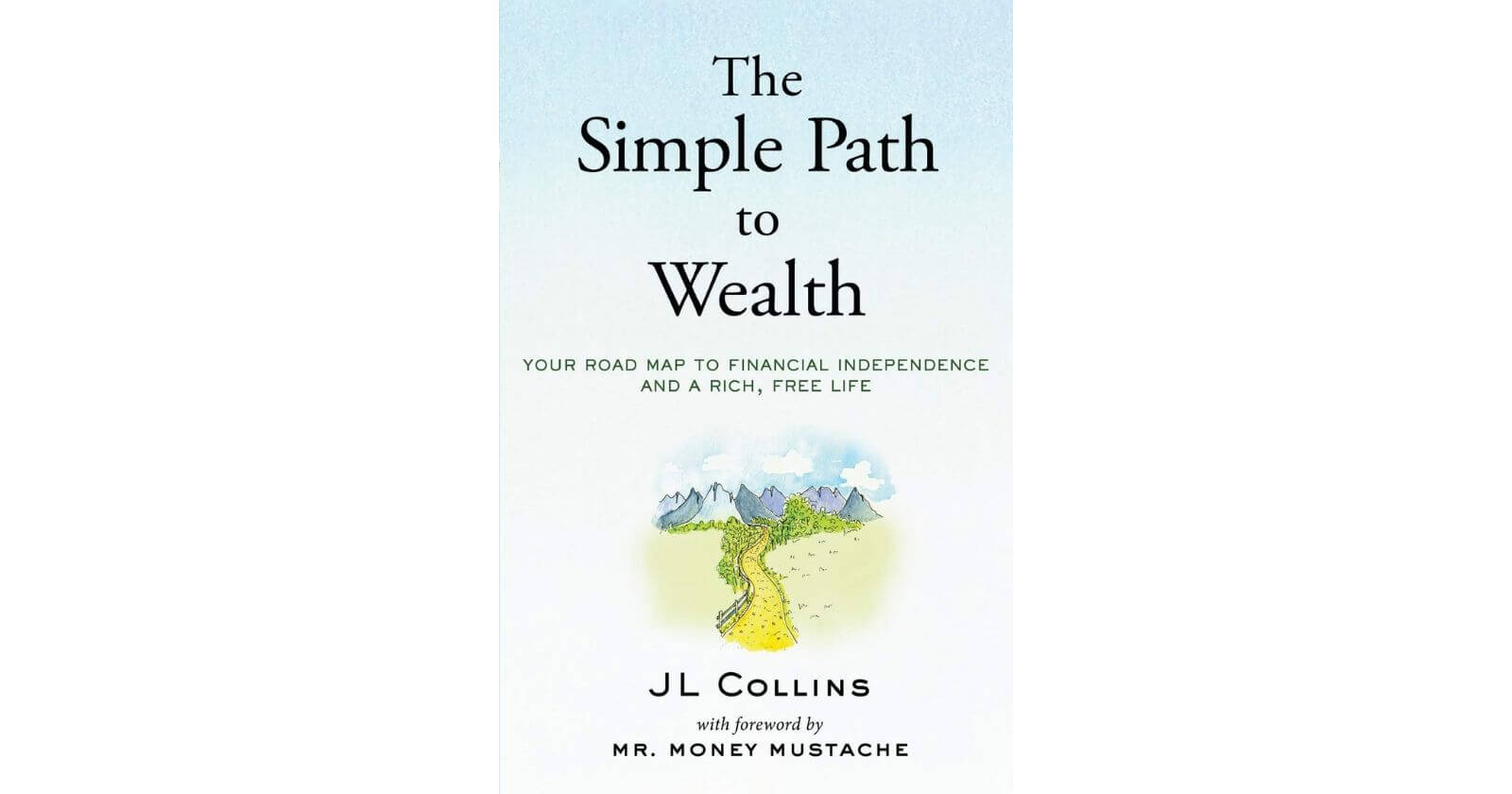I am beginning the 5-minute version series with one of the simplest, yet most powerful books in the personal finance arena: The Simple Path to Wealth by J L Collins.
Lines from this book have become veritable quotable quotes.
I wish I’d chanced upon this book earlier, it espouses all that is good, solid investing. Read on for a summary. And if you still want to read the book afterwards, you will not regret it one bit!
The Simple Path to Wealth
J L Collins wrote this book in 2016. It started as a series of letters to his daughter- to whom he wanted to impart the basic tenets of personal finance. This then morphed into his blog– and finally, this 239-page book.
Right in the beginning- after a foreword by Mr Money Mustache- Collins acknowledges that most people do not enjoy spending their time thinking about money. Including his daughter. However, since it is the tool to navigate this world, we must understand enough to manage it. He emphasizes that investments need not be complex. That complex investment instruments are made to be sold, not bought.
Wisdom in a few words
Collins starts the book by listing some core principles of getting wealthy.
- Spend less than you make and invest the rest.
- Stay away from debt.
- If you let it creep up, your lifestyle will enslave you
- Keep your distance from financially irresponsible people. And don’t marry one of those
- Be wary of financial advisors. They’re in it for themselves, not you.
- By the time you know enough to hire a good advisor, you know enough to invest by yourself.
- No one takes care of your money as well as you will.
- The most important thing money can buy is freedom.
- Not every decision in life needs to be about money- but recognize when you’re doing this.
- Good investing is simple.
And he ends with advice to save 50% of gross income to quickly attain “F-U money”.
“F-U Money”
I love how Collins unapologetically uses this word all through the book.
By this, he means having enough saved up to not necessarily retire, but have the freedom to walk away from a bad work situation. To take a break. Or switch to part-time. It sure resonates with us physicians at this time when burnout is rampant.
And this kind of freedom is priceless. It brings back “the joy of work when you aren’t effectively a slave to it”, he says.
Collins talks about how, as a family, they decided his wife should stay home with their daughter. What tilted the decision in favor of her staying home was the realization that there was nothing they could purchase that had as much value as her time spent with their child.
He does not stress the “multiple streams of income” philosophy and prefers to keep things simple.
He attributes his financial freedom to three pillars– which would work for anyone:
- Savings 50% of income
- Staying away from debt
- Investing with Vanguard
Stay Away From Debt
It is remarkable how commonplace large amounts of debt have become in our society- and it is the #1 reason which will keep many people away from financial freedom.
He explains how debt is a slippery slope… with life becoming consumed with paying down interest on the loans instead of focusing on financial well-being.
Collins recommends cutting down on all extra expenditure and plow it all towards the debt- beginning with the highest-interest ones.
The same discipline that gets you out of debt is what helps you get started on the road to financial independence. Once saving up becomes a habit- those same savings can now go towards investments.
A word on Mortgages
It is important to remember a home mortgage is also a debt- and it is doubtful how much of a “good debt” it is- given that it is so easy to overdo it.
Collins cautions you to “seek the least house to meet your needs rather than the most house you can technically afford” since it is not just the mortgage you have to service but all other expenses of maintaining a house, including taxes and insurance.
A house is an indulgence- which is fine, as long as you recognize that in purchasing such a house.
The State of Student Loans
The author rightfully bemoans the inflation rate of higher education in this country and the current state of Student Loans- and how it is almost unethical to yoke young adults without much financial savvy to so much debt. Especially the kind of debt for which wages and Social Security can be garnished and that doesn’t go away even in bankruptcy.
Can Everyone Retire a Millionaire?
Short answer, yes.
A relatively small amount- $12,000 invested for 40 years in a Total Stock Market Fund that replicates the market’s annual 12% gain over the years- grows to over $1 Million. Or $150 a month over the same time frame. Plugging in the numbers does it make sound a lot more achievable, doesn’t it?
That said, most people do not get there. Due to living large. And it happens with all ranges of income. Including the likes of Mike Tyson- who went bankrupt despite making $300 Million.
Opportunity Cost of Money
The author implores you to think about the opportunity cost of money every time you choose to spend it on anything discretionary.
This is what the object actually ends up costing you because you no longer have the money to invest it.
The opportunity cost relates to not only the initial cost of the object but also the the compound interest that initial capital would have earned over the years. That just keeps snowballing, as compound interest tends to do.
Total Stock Market: One and Done
Collins recommends investing with Vanguard- since it is the only Mutual Fund Company where the investors are also the owners. This avoids the problem of serving two masters- and only stands to benefit the investor-owner.
At Vanguard, in going with the principle of simplicity, Mr Collins recommends sticking to VTSAX- the Vanguard Total Stock Market Index Fund- for his entire stock allocation.
VTSAX follows the CRSP U.S. Total Market Index. It contains roughly 3700 companies.
Some tried and tested pieces of wisdom follow:
- Do not try to market time. It doesn’t work.
- Over time, like a span of 10 to 20 years, the market goes up- but it is a wild ride. You don’t have a choice but to brace for impact. “Toughen up cupcake”, in the author’s words.
- To successfully market-time, one would need to be right twice- to call the high and sell and again correctly call the low and buy it. The author calls it the “unwinnable game”.
- Downturns in the market will come, again and again. Rejoice if you’re in the accumulation phase- you get to buy more for a given amount.
- Don’t think of a downturn as the value of your investment going down. The underlying investment remains the same. For example, if you had 200 shares of VTSAX, you still have the exact same share of the companies held within VTSAX.
- The Index is “self-cleansing”. Companies that fail automatically fall off the Index, leaving behind the “winners”- and you get all this without having to choose individual winning stocks.
You have to come to terms with the volatility of the market. Remember during the gut-churning ride: the market ALWAYS goes up. This is because the “market” is actually real parts of companies you own- companies which are real businesses and livelihoods for millions of people.
Despite this, most people do not do as well as the funds they own and in fact, lose money investing the market. They accomplish this by:
- Trying to market-time- and therefore hopping in and out of funds exactly at the wrong times
- Trying to pick winning stocks
- Trying to pick winning actively-managed Mutual funds.
Simple is Effective
Index funds outperform actively managed funds most of the time.
A Vanguard Study found that over a 15 year time span, only 18% of actively managed funds outperformed the market.
Other studies have found that number is closer to zero.
Even when they do, it is hard to tell whether it’s skill or luck. Not only are these funds rare, but it is also impossible to know beforehand which fund will succeed and which will fail. Add to all of this, the high fees all actively managed mutual funds charge, and it becomes even more difficult to best the market.
If you are put off by the fact that Index Funds only return “market averages”, don’t be. In this case, “market averages” are better than what anything else can consistently get you.
Invest you must: Jack Bogle
- If you stay in cash, either under your mattress or in savings accounts, inflation eats away at the value of your capital. In a decade or two, the value of your money- in terms of its purchasing power- will be less than it was at the beginning. Keep no more than enough to meet your expenses and emergencies.
- Stocks are a hedge against inflation and the best tool to create wealth.
- Bonds help to smoothen the volatility of your portfolio and act as a hedge against deflation. For your bond allocation, Vanguard’s Total Bond Market Index Fund (VBTLX) is the way to go.
More About Bonds
- A bond is essentially money you loan to a company or to a government.
- The Total Bond Market Index Fund holds nearly 8000 individual bonds in it, all investment grade (high quality). That makes it broadly diversified. This reduces default risk.
- The higher the default risk of a bond, the more its interest rate to try and attract investors.
- These individual bonds also have different maturity dates, thereby mitigating interest rate risk.
- Bonds pay interest- this provides an income stream for those who need it. The interest remains unchanged until the bond matures. Hence, in times of deflation, this fixed amount has more purchasing power. This is why bonds are a hedge against deflation.
- Bond prices move in a direction opposite to interest rates. If current rates are higher than they used to be when you purchased your bond, no one wants to buy your bond- and the price it commands will fall.
- Longer term bonds pay out higher interest because (1) investors want to be paid more for tying up their money for longer and (2) because interest rates are more likely to rise, the longer the term of the bond- and decrease the value of their bond. At least, this is how it usually works. And that is called a “Normal Yield Curve“.
- When investors are expecting an economic downturn and associated deflation, they may pay more for shorter-term bonds than longer-term ones- thereby reversing the usual trend. This is known as an “Inverted Yield Curve“. And is usually a scary news headline.
- Bonds issued by the U.S. Federal Government are known as Treasuries, for short. They are of four types: bills, notes, bonds and TIPS.
- Bonds issued by State and Local Governments are called Municipal Bonds (Munis) and are exempt from Federal taxes and State income tax for the issuing state.
With this, we’ll end this post here and continue the rest of the book in part two. Thanks for reading! Which are your favorite parts of the book so far?
Please note, this post contains an affiliate link. This means if you purchase through this link, I will earn a small amount, without any additional cost to you.




